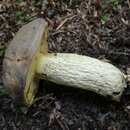Comprehensive Description
provided by North American Flora
Ceriomyces griseus (Frost) Murrill, Mycologia 1: 145. 1909
Boletus griseus Frost; Peck, Ann. Rep. N. Y. State Mus. 29 : 45. 1878.
Botetusjlexuosipes Peck, Bull. N. Y. State Mus. 8 : 130. 1889. (Type from North Carolina.)
Pileus broadly convex, 5-10 cm. in diameter ; 'surface subglabrous, smooth, dry, lightor dark-gray, rarely slightly brownish : context firm, whitish or grayish, yellowish in spots, unchanging ; tubes adnate, slightly depressed, somewhat decurrent at times, pure-white or whitish, becoming brownish with age and darker when bruised: spores ellipsoid, smooth, ochraceous-brown, 9-14X4-5/^: stipe fiexuous, whitish or yellowish, changing to brown •when bruised, rarely reddish toward the base, distinctly reticulate, firm, stuffed, becoming hollow at times, 5-10 cm. long, 0.5-1.3 cm. thick.
Type locality : Sandlake, New York. Habitat : On the g-round in open woods. Distribution : New England to North Carolina.
- bibliographic citation
- William Alphonso MurrilI, Gertrude Simmons BurIingham, Leigh H Pennington, John Hendly Barnhart. 1907-1916. (AGARICALES); POLYPORACEAE-AGARICACEAE. North American flora. vol 9. New York Botanical Garden, New York, NY
Retiboletus griseus: Brief Summary
provided by wikipedia EN
Retiboletus griseus, commonly known as the gray bolete, is a species of bolete fungus in the family Boletaceae. The species was first described scientifically in 1878 by American botanist Charles Christopher Frost. It was transferred to Retiboletus in 2002.
- license
- cc-by-sa-3.0
- copyright
- Wikipedia authors and editors

